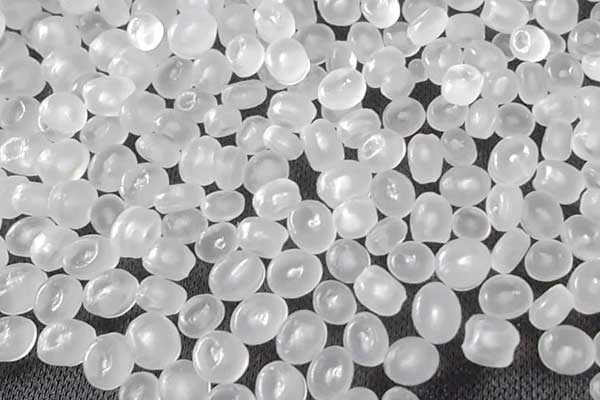
What Is HDPE – What Is The Difference Between PE/ HDPE/ LDPE?
With the development of industry, HDPE material is becoming more and more familiar and applied by many people. It is used in many familiar everyday products such as trash cans, detergent containers, toys, etc… So do you know what HDPE plastic is? In this article, US Masterbatch will help you learn more about high density polyethylene, its properties and applications.
1. What is HDPE?
HDPE (High Density Polyethylene) is a thermoplastic made from petroleum, with a high density molecular structure so it is thick, hard, and has better impact and stretch resistance than regular PE plastic. This is the most commonly used synthetic plastic in production today. HDPE plastic has a special molecular structure, consisting of ethylenes combined together to form long chains. This creates a flexible structure that can withstand pressure and impact, while also resisting dissolution and corrosion by chemicals and other environmental agents. With the above properties, HDPE is used in many industries such as packaging, manufacturing plastic products, plastic corrugated iron, plastic pallets, water pipes, drainage systems, toys, packaging, tanks, exhaust pipes, building materials…
Characteristic identification symbols on products made from HDPE plastic beads

The product will be stamped with a symbol as shown in the photo above. Its meaning is that the product is made from HDPE plastic.
2. PE/ HDPE/ LDPE. What is the difference?
We often hear PE plastic, HDPE plastic, LDPE plastic. These terms all have the same origin is Polyethylene. However, they also have some different properties. The main differences are density, molecular structure and application.
PE (Polyethylene) is the common name of synthetic plastic, formed through the polymerization of ethylene, in which ethylene molecules combine to form repeating units, forming the chain structure of polyethylene. PE plastic has many variations, of which the two main variations widely used today are HDPE and LDPE.
HDPE (High Density Polyethylene) is a type of plastic with a high density molecular structure, pressure and impact resistance, and resistance to dissolution and corrosion by chemicals and other environmental agents, so it is commonly used in the production of plastic pallets, water pipes, drainage systems, toys, tanks, exhaust pipes, construction materials…
LDPE (Low Density Polyethylene) is a type of plastic with a low density molecular structure, soft, flexible, elastic, creates a waterproof film, and is a good electrical insulator, so it is commonly used in the production of plastic packaging and plastic bags, food wrap, shrink wrap, toys and many plastic tools require high elasticity.
3. What are the characteristics of HDPE plastic?
HDPE is popular for many reasons and depends on individual and business needs. The most notable benefits are:
3.1. Easily melted and molded
One of the main benefits of this plastic comes from its malleability, making it easy to mold and transform into any shape or design. Once it reaches its melting point, this HDPE plastic is quickly and efficiently molded for exploitation in many unique applications from cutting boards, detergent bottles, milk jugs, food containers to pipes, plastic pallets and more again.
3.2. Light-weight
HDPE density ranges from 0.93 to 0.97g/cm3, high strength to density ratio, linear structure with little branching, this brings stronger intermolecular forces, higher tensile strength LDPE.
3.3. Anticorrosion
HDPE resists mold, insects and rot but is also durable and can be sterilized by boiling, making it an ideal material for food and beverage containers. In addition, HDPE can withstand most strong mineral acids and bases, and has good resistance to natural chemicals. Furthermore, this type of plastic is virtually impermeable to most common chemicals, water, solvents, acids, detergents, and is resistant to harsh weather.
3.4. Waterproof ability
High Density Polyethylene is waterproof, and unaffected by moisture. This makes it ideal in the construction industry, especially water pipes and reservoirs.
3.5. Sustainability
HDPE plastic is easily recycled, helping to keep non-biodegradable waste out of landfills, reducing plastic production by up to 50%. That is why many recyclable plastic items such as plastic pallets and industrial trash cans contain HDPE. If you are looking for cost-effective, environmentally responsible materials then this is the plastic for you.
3.6. Long lifespan
Because of its high impact resistance, chemical corrosion resistance, and weather resistance, HDPE lasts longer than traditional materials and continues its life cycle after recycling.
3.7. Recyclability
HDPE is an easy-to-recycle plastic, converting used High Density Polyethylene plastic into new products or recycled materials, helping to save resources, reduce plastic waste, and contribute to environmental sustainability.
4. High Density Polyethylene- Applications
Thanks to its mechanical properties and good solvent resistance, HDPE virgin plastic beads are widely used. From household products to specialized industrial products:
4.1. Industry
a, HDPE plastic pipes
HDPE plastic pipes are the most popular products. Pipes from this material are widely used in transporting liquids such as oil and water. With the ability to withstand acidic solvents without corrosion and leakage. The welds of HDPE pipes are very durable, so they are considered an ideal material for the gas industry.

b, HDPE Drums
The next product is a chemical container. Because it is resistant to many different types of solvents. So HDPE plastic pellets are the ideal material to make chemical containers. High hardness, good tensile strength, very safe in the chemical industry.

c, HDPE Furniture
Tables and chairs made from HDPE virgin plastic beads are the most common products we often use. Possesses good hardness, tensile strength and solvent resistance. Tables and chairs made from HDPE plastic are very suitable for outdoor use. Because rainwater often contains impurities and acids, it is very corrosive.

d, Automotive industry
HDPE is used in the production of fuel tanks, bumpers and other components in the automotive industry. HDPE’s excellent lightness, impact resistance and heat resistance make it a preferred material in automotive engineering.
- Packaging application
High density polyethylene is used in several packaging applications including cartons, trays, plastic pallets, milk and juice bottles, food packaging lids, etc…
- Consumer goods
Low cost and easy processing make HDPE the material of choice to make household and consumer goods such as trash cans, detergent containers, household appliances, ice boxes, toys, etc.

4.2. Packaging application
High density polyethylene is used in several packaging applications including cartons, trays, plastic pallets, milk and juice bottles, food packaging lids, etc…

4.3. Consumer goods
Low cost and easy processing make HDPE the material of choice to make household and consumer goods such as trash cans, detergent containers, household appliances, ice boxes, toys, etc. .

5. Conclusion
In short, HDPE is a synthetic plastic widely used in production thanks to its good physical and chemical properties, high hardness, tensile strength, good impact, chemical resistance, water resistance, and UV resistance. Through sharing about HDPE plastic, US Masterbatch JSC believe you will better understand them to use them effectively and safely in accordance with your life.
6. FAQs
6.1. What does HDPE stand for?
HDPE stands for “High-Density Polyethylene”, meaning High-Density Polyethylene because they have the polymer structure of Ethylene with a higher molecular density than regular Polyethylene.
6.2. Is HDPE plastic toxic?
HDPE plastic is not considered toxic. Under normal conditions, HDPE does not pose a danger to human health because it does not contain toxic additives such as bisphenol A (BPA) or phthalates, and does not emit dangerous pollutants when exposed to the environment.
6.3. Can HDPE plastic be reused?
Yes, HDPE plastic has high reusability due to its flexible, durable, and anti-corrosion properties, allowing it to be collected and reused in many cycles. The recycling process includes crushing, washing, and processing to recreate HDPE plastic pellets, which are then used to produce new products such as plastic bottles, water pipes, construction materials, containers, toys, and more many other things.









